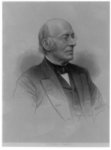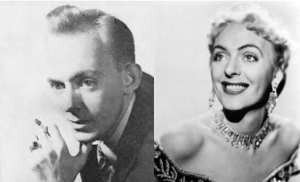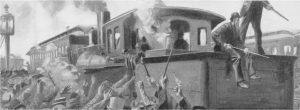As history has repeatedly shown, there is nothing that can conquer an individual with a persistent dream. No adversity is too strong and no action is too radical when one wishes to get one’s point across and make a difference in the world. This is very much the case for William Lloyd Garrison, the white abolitionist with strong passionate ideas about the structure and leadership of our country, especially in regards to slavery.
William Lloyd Garrison started expressing his love for writing his opinions at an extremely young age. His dreams of publishing his works led him to move to Boston, Massachusetts in 1829 at the age of twenty-four to become an editor for National Philanthropist. Although the newspaper over time proved to be unsuccessful, it gave him the opportunity to network with people that had seemingly similar ideals to his own. He became associated with the American Colonization Society, but that bridge was burned on July 4, 1829, when he gave his famous speech at Park Street Church.1
In that speech, Garrison openly criticized America, its ideas, and even the constitution. He states, “I say that our politics are rotten to the core. We boast of our freedom, who go shackled to the polls, year after year, by tens and hundreds and thousands! We talk of free agency, who are the veriest machines–the merest automata–in the hands of unprincipled jugglers!”2 He goes on to refer to the United States as “evil,” but more than anything, he seems to be the most concerned with the idea of slavery. This served as his opening speech as a leader in the abolitionist movement. The American Colonization Society quickly objected to the ill words used to describe the United States, and it was at that moment that he placed his own morals above the acceptance of any group.3 He disassociated himself from the American Colonization Society and decided to take on the fight on his own.
Garrison’s first step in expressing his ideas was starting a newspaper called The Liberator.4 This revolutionary newspaper debuted in 1831, and caused both praise and outrage from American citizens and officials alike for the next quarter century. His writings were known to be free and controversial, but like all other controversial topics, he had a large crowd of supporters. Once he knew he had plenty of attention, his actions began to correspond with his articles. He would say or do anything for the antislavery movement.
In 1854, he performed what many believe to be his most radical and passionate address of all time. During a July 4 speech, he set a copy of the constitution on fire and referred to it as “an agreement with hell.” He led the rest of the speech with the motto “No Union with Slaveholders.” This loud, expressive statement sparked a reaction even from people who did not even know of his event or cause.5 It did not take long for the news to spread. Newspapers were flooded with articles and political cartoons that displayed utter shock and confusion. A lot of the attention regarding this incident may have been negative, but it raised questions, such as “What’s going on here?” and “Who is he, and why his fury?” It made people listen and try to understand his cause even if they did not intend to do so. This brought so much attention to his cause and many people followed in his footsteps with their support.6
William Lloyd Garrison may have been a controversial figure, but he spoke in such a way that he was heard by all. He demonstrated that you didn’t have to be African American to be passionate about equal rights and he encouraged other white people to follow his example.
- Ronald Osborn, “William Lloyd Garrison and the United States Constitution: The Political Evolution of an American Radical,” Journal of Law and Religion 24 (December 2008): 82-85. ↵
- William Lloyd Garrison, “The Dangers of Slavery,” (address, Park Street Church, Boston, July 4, 1829). ↵
- Ronald Osborn, “William Lloyd Garrison and the United States Constitution: The Political Evolution of an American Radical,” Journal of Law and Religion 24 (December 2008): 82-85. ↵
- Ronald Osborn, “William Lloyd Garrison and the United States Constitution: The Political Evolution of an American Radical,” Journal of Law and Religion 24 (December 2008): 82-85. ↵
- Humanities, January 2013, s.v. “The Agitator William Lloyd Garrison and the Abolitionists,” by James Williford. ↵
- Fisher Banks, “What’s Going on Here?” Saturday Evening Post, 3 July 1954, 91. ↵



22 comments
Kendall Guajardo
This article really peaked my interest. I never knew too much about Garrison but it is quite amazing that he was able to be so controversial in a time like that. It sounds like he really wanted attention and what better way than to say your opinion in the strongest manner possible. I bet many people believed in his message but it must have sounded way too radical at the time. Despite the criticism, a strong one sided message was needed to push the abolitionist movement. I would like to know more about his early life and what got him into being a leader for the movement.
Nicholas Robitille
This article truly details a very unique man with a very unique approach towards abolition. While I can agree with his sentiments and message, I am not sure that his protest could have done much. At this time, the nation was very sharply divided into those who wanted slavery and those who didn’t. Garrison held a very loud opinion that he wasn’t afraid of showing. Other abolitionists of the time mainly tried much more subtle ways to fight against slavery. I believe this article was fairly well written, but would be aided by the addition of images to truly give the audience a better image of the man.
Olivia Tijerina
Reading a message from this article that others had made the ultimate sacrifice for others based off their empathy are the stories that are never forgotten. The message demonstrates this example of William Lloyd Garrison whom had just this. And in part had set a stone to a path that would lead to what he had desired most, A world without slavery.By his actions, his voice became louder than the actions what he had fought against, and it was learned and understood by the people because among his trajectory there was his actions that would reciprocate among the societal norms.
Cassandra Sanchez
Garrison is a truly courageous individual who spoke about the harsh reality of the way things were in this time. He put everything in jeopardy to speak for what he truly believes in, which is something very few can accomplish due to how the world may react to it and how the consequences may be. I never knew too much about him or what he had done but this was a very interesting article to read. It is always inspiring to read about those who are truly passionate and who stand up for what they believe in.
Samire Adam
Much like John Brown, I think William Lloyd Garrison had a powerful voice that was heard by a lot of people, but should have been heard by many more. William Lloyd Garrison was an educated man that strongly believed in his morals no matter the response that he would get from others and that is a respectable trait I can see in him as a historical figure because he was definitely moving in the right direction.
Gabriela Murillo Diaz
William Lloyd Garrison was a person who advocated for equal rights. I had not heard of him before this article and his story proved to be very interesting. We need more people like him in the world who are willing to advocate for those who sometimes cannot advocate for themselves. This was a very interesting, inspirational article that I am very glad I read. I would not have learned about this if it weren’t for this article. He is a great example to people who have privilege and how they use it.
Arieana Martinez
William Lloyd Garrison will always be an inspiration to us. He is a man who used the color of his skin to make a difference in the world and create bridges rather than walls to make the world a more inviting place to people of all races. He fought rather than hid in the shadows like most white individuals who felt that people of color deserved to be treated equally, but were too scared to act on those feelings. William Lloyd Garrison was a man of integrity and this article got his story right on point. Amazing article.
Sarah Nguyen
Loved how the author of the article included a summary of the speeches. I was about to pause my reading and research the background of the speech as I have found that many authors don’t include background information on some of the topic they touch on, but I didn’t have to when reading your article due to the awesome synopsis. Great job! This article would be even stronger if the author included more information on the effect Garrison had, and if any political change or move was caused due to him.
Isaac Saenz
Now here’s a guy whose actions speak louder than his words. It was a pleasure to learn more about William Lloyd Garrison and how he contributed to the equal rights movements. I had never heard of this man before in history but he proves to be someone worth knowing. This article was short and to the point, offered some interesting and significant events about the topic, and overall was a pretty nice piece. Good job.
Miranda Alamilla
Someone like William Lloyd Garrison is obviously someone we all aspire to be like. Someone who stands for what they believe in and fight for what they want – it is no doubt that he created such a controversial impact. Obviously, one of his most outstanding acts was setting the constitution on fire. This something only someone who 100% sure they are fighting for the right thing would do. Truly an inspiration to all. Great job Amanda!